日光温室后屋面投影宽度与墙体高度优化
2017-05-16曹晏飞荆海薇赵淑梅邹志荣鲍恩财
曹晏飞,荆海薇,赵淑梅,邹志荣※,鲍恩财
(1. 西北农林科技大学园艺学院农业部西北设施园艺工程重点实验室,杨凌 712100;2. 西北农林科技大学水利与建筑工程学院,杨凌 712100;3. 中国农业大学水利与土木工程学院,北京 100083)
日光温室后屋面投影宽度与墙体高度优化
曹晏飞1,荆海薇2,赵淑梅3,邹志荣1※,鲍恩财1
(1. 西北农林科技大学园艺学院农业部西北设施园艺工程重点实验室,杨凌 712100;2. 西北农林科技大学水利与建筑工程学院,杨凌 712100;3. 中国农业大学水利与土木工程学院,北京 100083)
关于日光温室合理的后屋面投影宽度、墙体高度一直存在争议。该文根据不同日期太阳直射光线在日光温室后墙上的投影高度变化,要求当室外最低温度低于0 ℃时,保证在中午前后4 h(10:00-14:00)内至少有一部分后墙能接受太阳光直射为条件,得出不同纬度地区日光温室墙体接受太阳光直射的合理时期,并据此得出日光温室后屋面投影宽度、墙体高度的计算方法。利用该方法对中国不同结构类型的日光温室后屋面投影宽度、墙体高度进行计算分析,结果显示后屋面投影宽度占跨度的比例为 0.04~0.23,其中纬度位于 34°~38°之间的西北地区日光温室后屋面投影宽度占跨度的比例最小,为0.04~0.11。该方法计算结果与典型日光温室结构参数吻合,具有可行性,可为中国日光温室的优化设计提供理论指导。
温室;温度;太阳辐射;后屋面;投影宽度;墙体高度;太阳直射光
曹晏飞,荆海薇,赵淑梅,邹志荣,鲍恩财. 日光温室后屋面投影宽度与墙体高度优化[J]. 农业工程学报,2017,33(7):183-189.doi:10.11975/j.issn.1002-6819.2017.07.024 http://www.tcsae.org
Cao Yanfei, Jing Haiwei, Zhao Shumei, Zou Zhirong, Bao Encai. Optimization of back roof projection width and northern wall height in Chinese solar greenhouse[J]. Transactions of the Chinese Society of Agricultural Engineering (Transactions of the CSAE), 2017, 33(7): 183-189. (in Chinese with English abstract)doi:10.11975/j.issn.1002-6819.2017.07.024 http://www.tcsae.org
0 引 言
日光温室是一种带有中国特色的温室形式,与其他温室类型相比,它具有低成本的良好越冬生产性能,在中国北方地区得到了大面积的推广[1-2]。近几十年来,科研人员提出了许多不同屋面形式的日光温室类型,如:无后屋面日光温室[3]、大棚型日光温室[4-5]、装配式日光温室[6]等。针对不同地区对日光温室合理结构参数的要求,研究人员开展了大量的试验研究[7-9],陈端生[10]建议以后屋面投影宽度占温室跨度的20%~25%进行设计,魏晓明等[11]指出以种植区最后一排作物冠层可接受到夏至日正午太阳光为基准来确定后屋面的投影宽度,白义奎等[12]以冬至日日光温室采光面截获的太阳能与春分日地平面截获的太阳能相等来计算后屋面的投影宽度,郭艳玲等[13]认为在哈尔滨地区,后屋面投影宽度应为温室脊高的24%~25%,在2003年的国家标准中规定日光温室的后屋面投影宽度应为温室跨度的 17%~25%[14]。综上所述,目前关于合理的后屋面投影宽度在各地的日光温室建造过程中存在较大争议。
日光温室墙体作为温室的围护结构之一,其所具备的保温蓄热性能是日光温室进行越冬蔬菜栽培生产的关键。研究人员在墙体材料[15-16]、构造方式[17]以及传热性能[18-19]等方面开展了大量的研究。温室墙体内侧温度的变化幅度与太阳光直射密切相关[20],墙体接受太阳光照射的面积越大,则温室保温蓄热效果越好[21]。在相同温室长度条件下,墙体高度越大,则日光温室中接受太阳光直射的墙体面积越大。因此在寒冷季节,可通过增加墙体高度使得墙体接受太阳光直射的面积增大,从而提高温室墙体的蓄热量。随着外界气温升高,室内外温差减少,墙体接受太阳光直射的高度也在降低,直至为0。接受太阳光直射的墙体高度过早或过晚接近于 0均不利于日光温室的自发温度调控,因此选择墙体接收太阳直射的合理周期对日光温室的保温蓄热调节尤为关键。本研究拟根据不同地区的气候特点,确定不同地区日光温室墙体接受太阳光直射的合理周期,基于日光温室接受太阳直射的墙体高度计算出合理的后屋面投影宽度与墙体高度,将计算结果与实际典型温室结构参数对比分析,并验证该计算方法可行性。
1 日光温室墙体接受太阳直射的合理周期
日光温室墙体一般具有保温和蓄热双重功能,主要通过白天吸收太阳辐射来蓄积热量,夜间再缓慢地将热量释放到室内[22],墙体保温可将温室的供热需求减少多达31.7%[23]。
日光温室主要分布在中国的东北地区、华北地区、西北地区、黄淮海及环渤海地区,表1为1998-2012年中国北方部分城市在1-6月的月平均最低气温和月平均最高气温。从表 1可看出,北京、石家庄、济南、西安地区在4月份的平均最低温度已超过0 ℃,平均最高温度已接近或超过30 ℃;太原、呼和浩特、沈阳、长春、哈尔滨、兰州、西宁、银川、乌鲁木齐在 5月份的平均最低温度均已超过 0 ℃,除西宁外,其他城市的平均最高温度均已超过30 ℃,说明即使在5月份,青海西宁地区的室外气温相对较低。以青海西宁地区一个标准的冬暖式日光节能温室为例,随着季节变化,春季温室内外温差较冬季有所降低,其中 3~5月温室内外最小温差出现时间为18:00~20:00,4月份最小温差为4.5~5.8 ℃[24]。由表1可知,西宁地区 4月份月平均最低气温为−5.0 ℃,室内气温可能会低于5.8 ℃,而果菜类蔬菜主要利用日光温室进行越冬生产,以番茄为例,其在夜间生长发育的低限空气温度为 5 ℃,夜间适宜空气温度为 8~13 ℃[25],因此即使在 4月份,青海西宁地区日光温室墙体白天应该接受太阳光直射来蓄积热量,以便夜间为温室提供更多的热量。
同时,青海地区日光温室内外最大温差出现时间为9:00~11:00,5月份最大温差为15.4~17.3 ℃[24]。由表1可知,西宁地区5月份平均最高气温为26.9 ℃,温室内气温可能会高于 41.3 ℃,而番茄在白天的最高界限温度35 ℃[25],因此在此时间段内,日光温室墙体白天接受太阳光直射所蓄积的热量反而不利于植物生长。
考虑到中国北方大部分城市月平均最低温度接近或超过0 ℃时,月平均最高温度已接近或超过30 ℃,因此提出当室外最低温度低于0 ℃时,应保证在正午前后4 h (10:00-14:00)内至少有一部分日光温室后墙能够接受太阳光直射。依据表 1中不同城市的月平均温度[26],结合中国传统的24节气特点,提出西安地区日光温室墙体接受太阳光直射的时期为白露至清明,北京、石家庄、济南等地区日光温室墙体接受太阳光直射的时期为处暑至谷雨,太原、呼和浩特、沈阳、长春、哈尔滨、兰州、银川、乌鲁木齐等地区日光温室墙体接受太阳光直射的时期为立秋至立夏,同时考虑到西宁地区月平均最高温度低于30 ℃,因此建议西宁地区日光温室墙体接受太阳光直射的时期为大暑至小满。
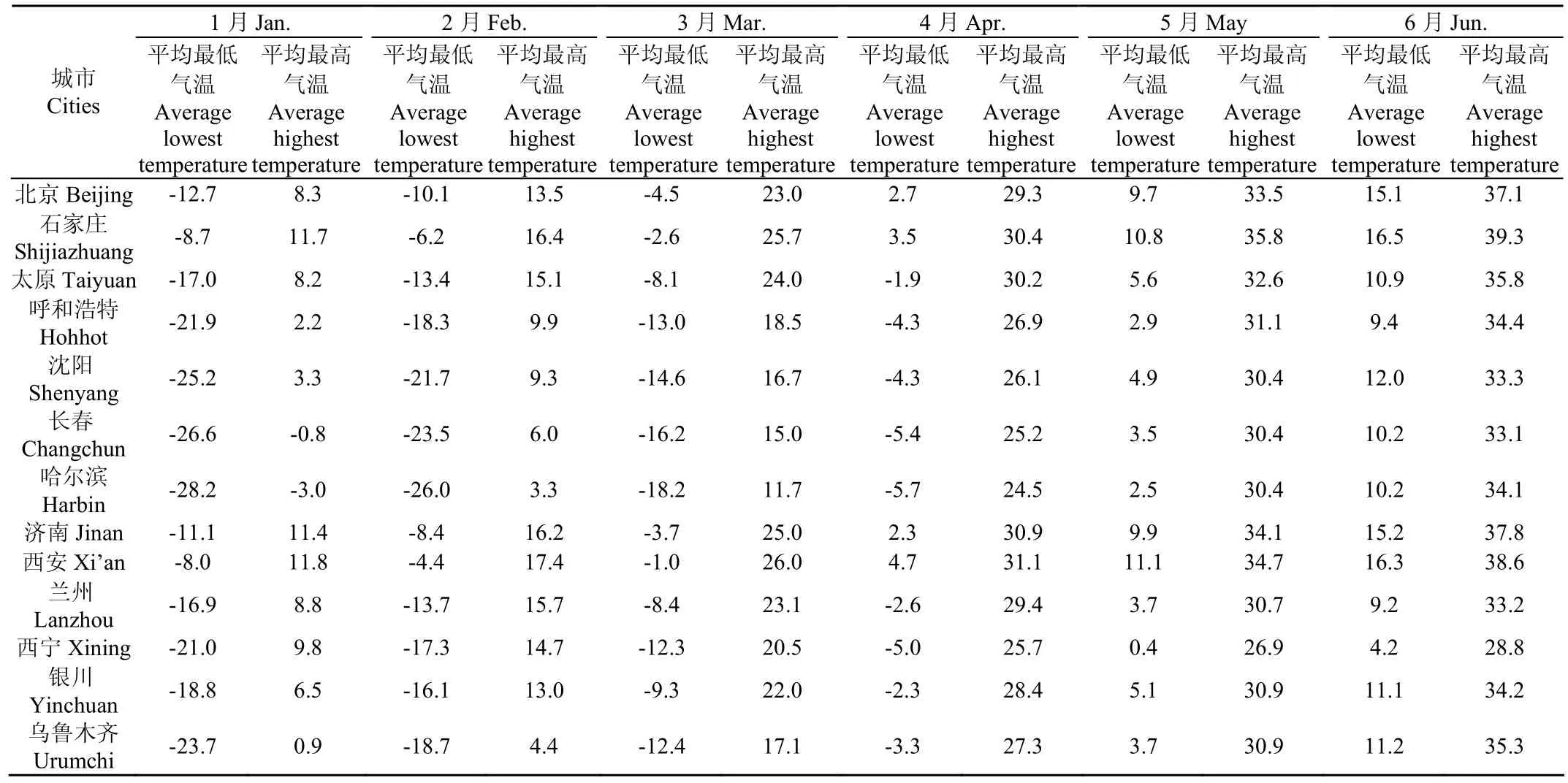
表1 1998-2012年1-6月部分城市的月平均最低气温与月平均最高气温Table1 Average monthly lowest temperature and average monthly highest temperature in selected cities from January to June in 1998-2012
2 日光温室后屋面投影宽度确定方法
日光温室在中国北方地区的越冬蔬菜栽培生产中发挥着极其重要的作用,它的屋面主要是由前屋面和后屋面2部分组成。
2.1 日光温室前屋面倾角
前屋面是指屋脊与温室前脚的连线,是日光温室的主要采光面。屋面形状和屋面倾角是前屋面的 2个基本参数,由于不同弧面形状的采光屋面对温室总进光量的影响差别不大[27],因此,试验过程不考虑前屋面弧面形状对温室采光的影响。
针对不同地区日光温室前屋面倾角,研究人员开展了大量的研究,采光设计的基本原则是保证在冬至日正午前后4 h内(10:00-14:00)日光温室能获得最大采光量,考虑到入射角在一定范围内透光率变化较小,选用入射角为43°[11]。
依据冬至日10:00的太阳高度角和方位角,确定相对应的温室前屋面角,计算公式为[11]

式中α表示日光温室的合理前屋面倾角,γ10W表示冬至日上午10:00的太阳方位角,(°);α10W=90°−43°−h10W,h10W表示冬至日上午10:00的太阳高度角,(°)。
太阳高度角h是指太阳直射光线与地平面的夹角,可由式(2)确定[28]。

式中φ表示地理纬度,(°);ω=15°×(12−t),t表示太阳计算时,h;δ表示太阳赤纬角,(°),计算如下

式中N表示日序数,d,为计算日距1月1日天数。
太阳方位角γ是指太阳直射光线在水平面上的投影与正南方的夹角。不同时刻的太阳方位角γ计算如下[28]

2.2 日光温室后屋面投影宽度
日光温室后屋面是指从屋脊到后墙的保温屋面,其沿跨度方向的水平投影为后屋面投影宽度。白天太阳直射光线透射过日光温室前屋面,在地面上的投影如图 1所示。
根据三角函数关系可知
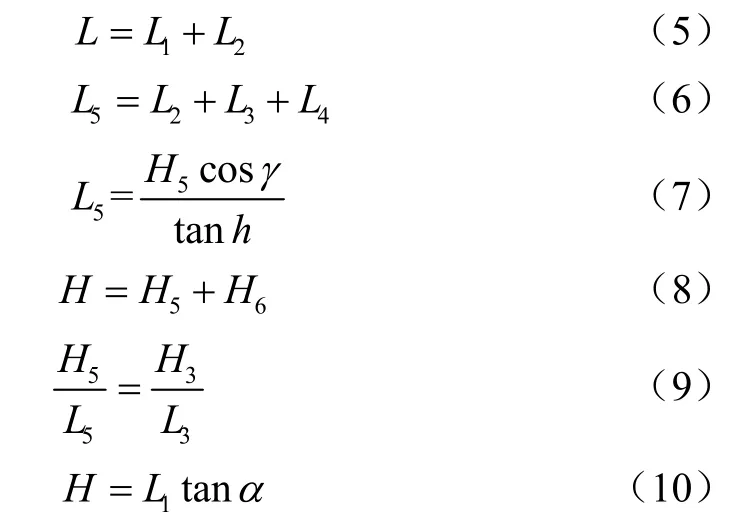
联合式(5)~(10),得日光温室后屋面水平投影宽度

式中参数详见图1,L4取值为0.8 m[29],在日光温室建设过程中,前屋面在屋脊处的坡度不应小于 8°,H6≥L4×tan(8°)=0.11 m,H6取值为0.2 m。
显然,日光温室后屋面水平投影宽度与温室长度、前屋面角、后墙接受太阳光直射的高度、保温被卷放位置、太阳高度角以及太阳方位角有关。
3 日光温室墙体高度确定方法
日光温室墙体可直接影响室内热环境,墙体越高,则温室保温性越好[21]。根据图1,则有

根据第 2节确定后屋面投影宽度L2,冬至日上午10:00接受太阳光直射的墙体高度H3W计算公式

为了使得冬季日光温室墙体尽可能多的蓄积热量,应保证H1≥H3W。
日光温室脊高计算公式

日光温室后屋面角计算公式

式中参数详见图1。
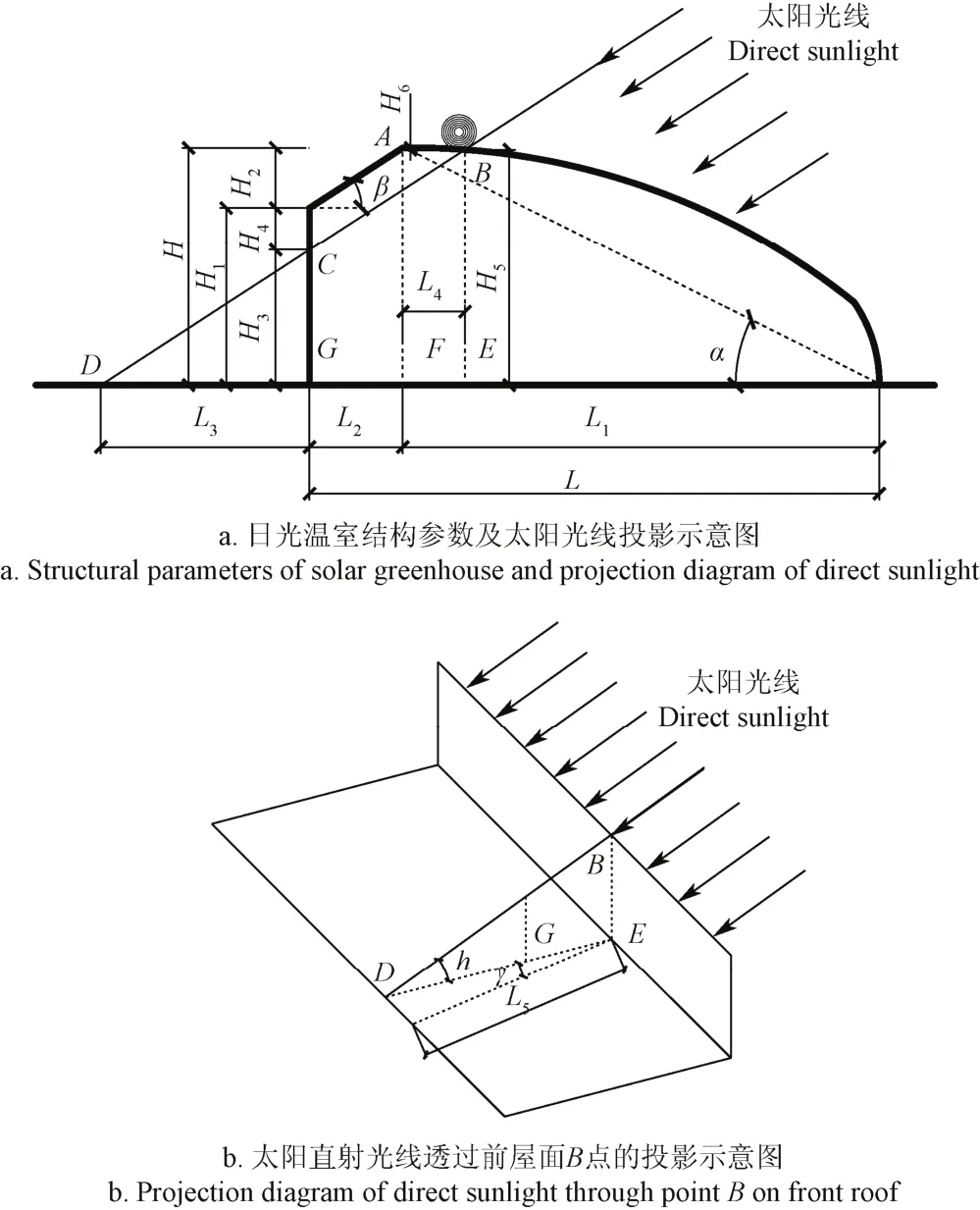
图1 太阳直射光线透射过日光温室前屋面的投影示意图Fig.1 Projection diagram of direct solar radiation through front roof in solar greenhouse
为了保证更多的太阳光进入温室内,日光温室设计过程中应将后屋面角略大于冬至日正午太阳高度角[12],则

联合式(14)、式(16),则

4 方法验证
为了验证本文所提出方法的合理性,选用文献[8]的日光温室结构尺寸数据进行分析,杨凌地区日光温室主体结构参数如表2所示。

表2 杨凌地区日光温室结构尺寸参数Table2 Structural dimension parameters of solar greenhouses in Yangling
根据本文研究方法计算得到陕西杨凌地区,跨度为8、9和10 m的日光温室在冬至日上午10:00接受太阳光直射的墙体高度分别为2.22、3.03和3.00 m,均小于墙体高度,其中9和10 m跨度日光温室的墙体蓄热面积相近,均要大于8 m跨度日光温室,不过跨度为10 m日光温室的容积、地面蓄热面积均要比跨度为9 m日光温室大,所以10 m跨度日光温室内热环境应该是3个温室中最好的,这与文献[8]的试验结果即10 m跨度日光温室的平均气温是3个温室中最高的相吻合。
同时,结合8、9和10 m跨度日光温室的结构尺寸参数,利用本文提出的西安地区日光温室墙体接受太阳光直射的时期为白露至清明,计算得到不同日光温室的后屋面投影宽度分别为1.00、1.58和1.56 m,与实际日光温室后屋面投影宽度尺寸接近。
为了验证本文提出的日光温室墙体接受太阳直射的合理周期,选择以山东寿光厚土墙下沉型日光温室为对象。该类型日光温室由于其低成本和良好的保温蓄热性能,在中国北方地区得到了大面积的应用。跨度为10 m典型寿光型日光温室的前屋面倾角、脊高、下沉深度、墙体高度以及后屋面投影宽度分别为22.7°、3.85、0.4、3.1以及0.8 m[30]。
根据本文方法计算得到山东寿光地区寿光型日光温室墙体在不同节气可接受太阳光直射的墙体高度如图2所示。显然,谷雨时节之后,中午前后4 h内接受太阳光直射的寿光型日光温室墙体高度接近于0,这与本文第 1节提出的山东地区日光温室墙体接受太阳光直射的时期(处暑至谷雨)一致。说明本文提出的不同地区日光温室墙体接受太阳光直射的合理周期有一定的可操作性。
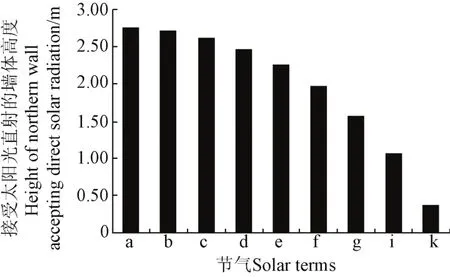
图2 不同节气接受太阳光直射的寿光型日光温室墙体高度Fig.2 Height of northern wall in Shouguang solar greenhouse accepting direct solar radiation in different solar terms
5 结果与分析
假设在不同纬度地区建造一栋正南方向的日光温室,前屋面角按照合理屋面角设计,根据前文得到的墙体合理蓄热周期取值、温室结构计算公式,不同地区的日光温室后屋面投影宽度、脊高、墙体高度如表3所示。
分析表 3得知,不同地区日光温室的后屋面投影宽度占跨度的比例为 0.04~0.23,范围比国家标准中的0.17~0.25[14]更加宽泛,其中比例最小的地区位于太原、兰州、西宁、银川等低纬度冬季寡日照或寒冷地区,仅为0.04~0.11。当温室跨度、脊高一定时,后屋面投影宽度所占比例越小,则后墙高度越高,严寒冬季接受太阳光直射的墙体面积也将增加。目前在中国北方地区推广应用较为广泛的寿光型日光温室后屋面投影宽度所占比例仅为 0.08[30],这种短后坡日光温室在一定程度上有助于改善日光温室热环境,叶林等[3]对后屋面投影宽度为0的无后屋面日光温室进行环境测试,结果表明该类型日光温室具有较好的采光效果,但其在最冷1月份的室内平均温度要低于后屋面长度为1 m的日光温室,因此后屋面投影长度并不是越低越好,在寒冷地区可以适当降低后屋面投影宽度来提高墙体高度,增加温室的蓄热面积,在温暖地区可以适当提高后屋面投影宽度,降低蓄热墙体高度,避免春季温室内温度过高,尤其是近年来科研人员提出各种蓄热方式[31-33]来改善日光温室的热环境。
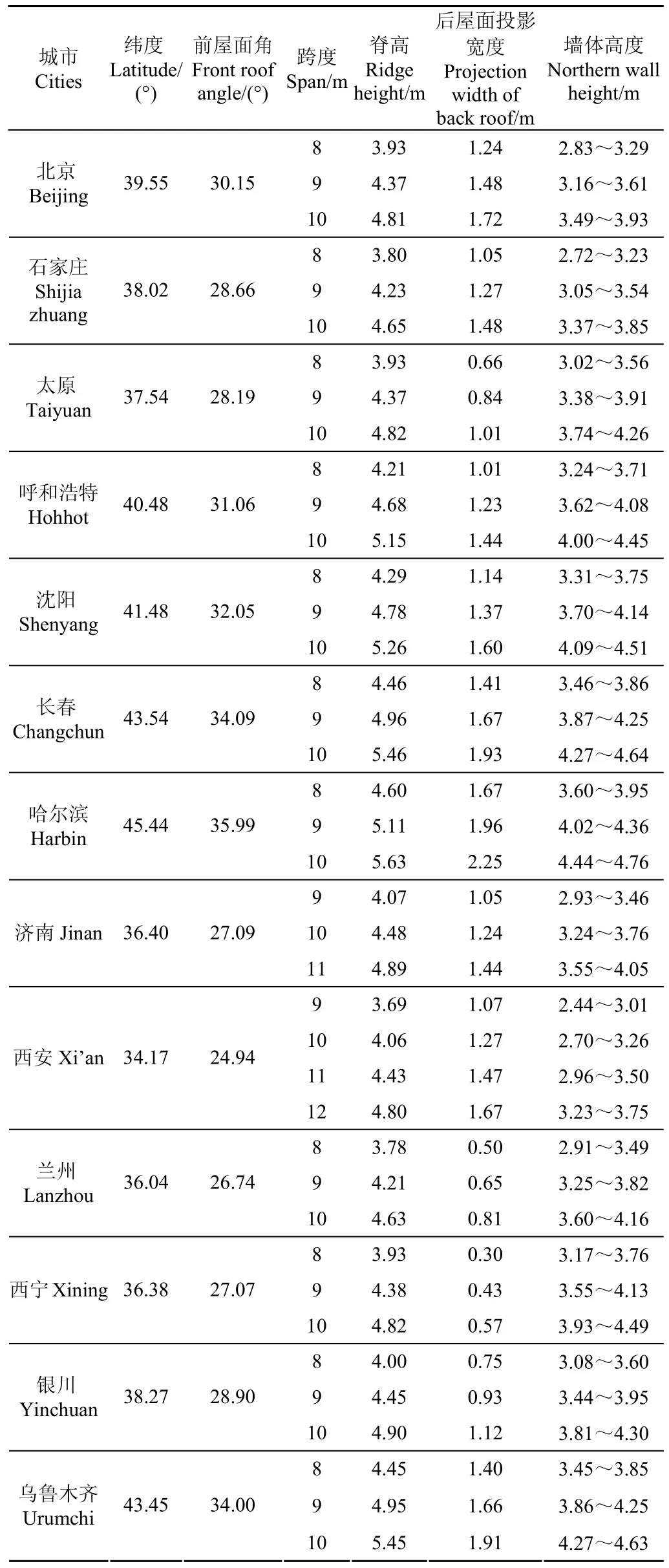
表3 不同地区日光温室后屋面投影宽度、脊高、墙体高度Table3 Projection width of back roof, ridge height and northern wall height of solar greenhouse in different areas
6 结 论
1)本文根据 1998-2012年不同地区的月平均温度变化,提出当室外最低温度低于 0 ℃时,应保证中午前后 4 h内至少有一部分日光温室墙体能接受太阳光直射为条件,得出不同地区日光温室后墙接受太阳光直射的合理周期,以及一种后屋面投影宽度与墙体高度的取值方法。
2)利用目前应用较为广泛的寿光型日光温室结构参数,计算其后墙在中午前后4 h内能接受太阳光直射的时期,并与本文所提出山东地区日光温室墙体接受太阳光直射的时期进行比较,结果显示二者相吻合,表明该方法具有一定的可信度。
根据本文提出计算方法得出不同地区日光温室后屋面投影宽度和墙体高度等参数,可为中国日光温室规范化设计提供参考。
[1] 徐凡,马承伟,曲梅,等. 华北五省区日光温室微气候环境调查与评价[J]. 中国农业气象,2014,35(1):17-25. Xu Fan, Ma Chengwei, Qu Mei, et al. Investigation and assessment on microclimate environment of solar greenhouse in north China[J]. Chinese Journal of Agrometeorology, 2014, 35(1): 17-25. (in Chinese with English abstract)
[2] 魏晓明,周长吉,曹楠,等. 中国日光温室结构及性能的演变[J]. 江苏农业学报,2012,28(4):855-860. Wei Xiaoming, Zhou Changji, Cao Nan, et al. Evolution of structure and performance of Chinese solar greenhouse[J]. Jiangsu Journal of Agricultural Sciences, 2012, 28(4): 855-860. (in Chinese with English abstract)
[3] 叶林,李建设,张光弟,等. 宁南山区经济节能型日光温室优化选型研究[J]. 新疆农业科学,2014,51(6):1022-1027. Ye Lin, Li Jianshe, Zhang Guangdi, et al. Research on optimal selection of economical solar greenhouse with energy saving in the mountainous area of southern Ningxia[J]. Xinjiang Agricultural Sciences, 2014, 51(6): 1022-1027. (in Chinese with English abstract)
[4] 崔世茂,陈源闽,霍秀文,等. 大棚型日光温室设计及光效应初探[J]. 农业工程学报,2005,21(增刊):214-217. Cui Shimao, Chen Yuanmin, Huo Xiuwen, et al. Design of the solar lean-to greenhouse without wall and preliminary study on the photoeffect[J]. Transactions of the Chinese Society of Agricultural Engineering, 2005, 21(Supp.): 214-217. (in Chinese with English abstract)
[5] 韩丽蓉,王宏丽,李凯,等. 下沉式大跨度大棚型温室的设计及应用研究[J]. 中国农业大学学报,2014,19(4):161-165. Han Lirong, Wang Hongli, Li Kai, et al. Design and application study on the sinking and great-span greenhouse without back wall[J]. Jourmal of China Agricultural University, 2014, 19(4): 161-165. (in Chinese with English abstract)
[6] 孙周平,黄文永,李天来,等. 彩钢板保温装配式节能日光温室的温光性能[J]. 农业工程学报,2013,29(19):159-167. Sun Zhouping, Huang Wenyong, Li Tianlai, et al. Light and temperature performance of energy-saving solar greenhouse assembled with color plate[J]. Transactions of the Chinese Society of Agricultural Engineering (Transactions of the CSAE), 2013, 29(19): 159-167. (in Chinese with English abstract)
[7] 金鲜华,邹志荣,赵雪. 跨度对山地日光温室性能的影响[J].农机化研究,2015,37(2):146-150. Jin Xianhua, Zou Zhirong, Zhao Xue. The span effect on montanic solar greenhouse[J]. Journal of AgriculturalMechanization Research, 2015, 37(2): 146-150. (in Chinese with English abstract)
[8] 刘彦辰,邹志荣,胡晓辉,等. 陕西关中地区不同跨度日光温室光温环境分析[J]. 西北农林科技大学学报:自然科学版,2013,41(2):108-116. Liu Yanchen, Zou zhirong, Hu Xiaohui, et al. Analysis of light and temperature conditions of sunlight greenhouses with different span lengths in central Shaanxi plain[J]. Journal of Northwest A&F University: Natural Science Edition, 2013, 41(2): 108-116. (in Chinese with English abstract)
[9] 杨文雄,马承伟. 温室跨度对日光温室光照环境的影响模拟研究[J]. 农机化研究,2015,37(9):70-72. Yang Wenxiong, Ma Chengwei. Simulation study of influence on greenhouse span on greenhouse light environment[J]. Journal of Agricultural Mechanization Research, 2015, 37(9): 70-72. (in Chinese with English abstract)
[10] 陈端生. 日光温室采光和保温设计要点[J]. 新疆农机化,2004(3):51—53.
[11] 魏晓明,周长吉,曹楠,等. 基于光照的日光温室总体尺寸确定方法研究[J]. 北方园艺,2010(15):1-5. Wei Xiaoming, Zhou Changji, Cao Nan, et al. Deisgn method for solar greenhouse outlines based on illumination conditions[J]. Northern Horticulture, 2010(15): 1-5. (in Chinese with English abstract)
[12] 白义奎,周东升,曹刚,等. 北方寒区节能日光温室建筑设计理论与方法研究[J]. 新疆农业科学,2014,51(6):990-998. Bai Yikui, Zhou Dongsheng, Cao Gang, et al. Research on solar greenhouse architectural design theory and method during winter time in Northern cold regions of China[J]. Xinjiang Agricultural Sciences, 2014, 51(6): 990-998. (in Chinese with English abstract)
[13] 郭艳玲,李石,陈国辉. 后屋面水平投影长度对日光温室性能的研究[J]. 安徽农业科学,2014,42(5):1555-1557. Guo Yanling, Li Shi, Chen Guohui. Different roof horizontal projection length on the performance of greenhouse[J]. Journal of Anhui Agricultural Sciences, 2014, 42(5): 1555-1557. (in Chinese with English abstract)
[14] 日光温室和塑料大棚结构与性能要求:JB/T10594-2006. [S]. 北京:中国标准出版社,2006:7.
[15] 张洁,邹志荣,张勇,等. 新型砾石蓄热墙体日光温室性能初探[J]. 北方园艺,2016(2):46-50. Zhang Jie, Zou Zhirong, Zhang Yong, et al. Performance of heating storagegravel wall solar greenhouse[J]. Northern Horticulture, 2016(2): 46-50. (in Chinese with English abstract)
[16] 管勇,陈超,李琢,等. 相变蓄热墙体对日光温室热环境的改善[J]. 农业工程学报,2012,28(10):194-201. Guan Yong, Chen Chao, Li Zhuo, et al. Improving thermal environment in solar greenhouse with phase-change thermal storage wall[J]. Transactions of the Chinese Society of Agricultural Engineering (Transactions of the CSAE), 2012, 28(10): 194-201. (in Chinese with English abstract)
[17] 卢志权,刘在民,于锡宏,等. 不同凹式墙体对温室蓄热性能的影响[J]. 浙江大学学报:理学版,2013,40(3):344-347. Lu Zhiquan, Liu Zaimin,Yu Xihong, et al. Effects of different concave type structure wall on thermal performance in the greenhouse[J]. Journal of Zhejiang University: Science Edition, 2013, 40(3): 344-347. (in Chinese with English abstract)
[18] 李明,周长吉,魏晓明. 日光温室墙体蓄热层厚度确定方法[J]. 农业工程学报,2015,31(2):177-183. Li Ming, Zhou Changji, Wei Xiaoming. Thickness determination of heat storage layer of wall in solar greenhouse[J]. Transactions of the Chinese Society of Agricultural Engineering (Transactions of the CSAE), 2015, 31(2): 177-183. (in Chinese with English abstract)
[19] 何芬,周长吉. 日光温室土质墙体温度与吸放热量测试分析[J]. 北方园艺,2015(10):58-61. He Fen, Zhou Changji. Analysis on test of wall temperature distribution and heat flux in solar greenhouse[J]. Northern Horticulture, 2015(10): 58-61. (in Chinese with English abstract)
[20] 温祥珍,李亚灵. 日光温室砖混结构墙体内冬春季温度状况[J]. 山西农业大学学报:自然科学版,2009,29(6):525-528. Wen Xiangzhen, Li Yaling. Analysis of temperature within north composite wall of solar greenhouse[J]. Journal of Shanxi Agricultural University: Natural Science Edition, 2009, 29(6): 525-528. (in Chinese with English abstract)
[21] 温祥珍,梁海燕,李亚灵,等. 墙体高度对日光温室内夜间气温的影响[J]. 中国生态农业学报,2009,17(5):980-983. Wen Xiangzhen, Liang Haiyan, Li Yaling, et al. Effect of wall height on air temperature of greenhouse during night[J]. Chinese Journal of Eco-Agriculture, 2009, 17(5): 980-983.(in Chinese with English abstract)
[22] 马承伟,卜云龙,籍秀红,等. 日光温室墙体夜间放热量计算与保温蓄热性评价方法的研究[J]. 上海交通大学学报:农业科学版,2008,26(5):411-415. Ma Chengwei, Bu Yunlong, Ji Xiuhong, et al. Method for calculation of heat release at night and evaluation for performance of heat preservation of wall in solar greenhouse[J]. Journal of Shanghai Jiaotong University: Agricultural Science, 2008, 26(5): 411-415. (in Chinese with English abstract)
[23] Mobtaker H G, Ajabshirchi Y, Ranjbar S F, et al. Solar energy conservation in greenhouse: Thermal analysis and experimental validation[J]. Renewable Energy, 2016, 96: 509-519.
[24] 朱宝文,胡德奎,赵年武,等. 高寒冷凉地区日光温室温度变化规律研究[J]. 中国农学通报,2014,30(7):156—161. Zhu Baowen, Hu Dekui, Zhao Nianwu, et al. Research on the temperature variation in greenhouse in alpine cold regions[J]. Chinese Agricultural Science Bulletin, 2014, 30(7): 156-161. (in Chinese with English abstract)
[25] 邹志荣,邵孝侯. 设施农业环境工程学[M]. 北京:中国农业出版社,2008.
[26] 中国气象年鉴编辑部. 中国气象年鉴[M]. 北京:气象出版社,1999-2013.
[27] 轩维艳. 日光温室采光屋面曲线数学模型的建立与分析[J].天津农业科学,2006,12(4):44-46. Xuan Weiyan. Mathematical model establishment and analysis for greenhouse surface curve[J]. Tianjian Agricultural Sciences, 2006, 12(4): 44-46. (in Chinese with English abstract)
[28] 彦启森,赵庆珠. 建筑热过程[M]. 北京:中国建筑工业出版社,1986.
[29] 北京众博熙泰农业科技有限公司. 节能日光温室屋面参数设计[J]. 农业工程技术:温室园艺,2015(11):92-93.
[30] 山东ⅠⅡⅢⅣⅤ型日光温室(冬暖大棚)建造技术规范:DB37/T391-2004. [S]. 2004:05.
[31] 周升,张义,程瑞锋,等.大跨度主动蓄能型温室温湿环境监测及节能保温性能评价[J]. 农业工程学报,2016,32(6):218-225. Zhou Sheng, Zhang Yi, Cheng Ruifeng, et al. Evaluation on heat preservation effects in micro-environment of large-scale greenhouse with active heat storage system[J]. Transactions of the Chinese Society of Agricultural Engineering (Transactions of the CSAE), 2016, 32(6): 218-225. (in Chinese with English abstract)
[32] 管勇,陈超,凌浩恕,等. 日光温室三重结构相变蓄热墙体传热特性分析[J]. 农业工程学报,2013,29(21):166—173. Guan Yong, Chen Chao, Ling Haoshu, et al. Analysis of heat transfer properties of three-layer wall with phase-change heat storage in solar greenhouse[J]. Transactions of the Chinese Society of Agricultural Engineering (Transactions of the CSAE), 2013, 29(21): 166-173. (in Chinese with English abstract)
[33] 张勇,高文波,邹志荣. 日光温室主动蓄热后墙传热CFD模拟及性能试验[J]. 农业工程学报,2015,31(5):203—211. Zhang Yong, Gao Wenbo, Zou Zhirong. Performance experiment and CFD simulation of heat exchange in solar greenhouse with active thermal storage back-wall[J]. Transactions of the Chinese Society of Agricultural Engineering (Transactions of the CSAE), 2015, 31(5): 203-211. (in Chinese with English abstract)
Optimization of back roof projection width and northern wall height in Chinese solar greenhouse
Cao Yanfei1, Jing Haiwei2, Zhao Shumei3, Zou Zhirong1※, Bao Encai1
(1.The Agriculture Ministry Key Laboratory of Protected Horticultural Engineering in Northwest,Department of Horticulture,Northwest A&F University, Yangling712100,China; 2.College of Water Resources and Architectural Engineering, Northwest A&F University,Yangling712100,China; 3.College of Water Resources & Civil Engineering, China Agricultural University, Beijing100083,China)
The typical Chinese solar greenhouse, compared to other types of greenhouse, has the properties of low construction cost and low energy consumption when operating during winter days, which draws the attention of the researcher in the field of facility horticulture. In recent years, the structural parameters, such as span, ridge height and wall thickness in Chinese solar greenhouse have been extensively studied. However, the correlation relationship between reasonable back roof projection width (BRPW) and northern wall height (NWH) have always been inconsistent and require further investigation. In this study, a new method for calculating BRPW and NWH was obtained based on the reasonable periods where the northern wall surface
irect solar radiation in different latitude regions. Firstly, the average monthly lowest temperature and the average monthly highest temperature were statistically analyzed in some cities from January to June in 1998-2012. The data showed that when the average monthly lowest temperature was close to or exceeded 0 ℃, the average monthly highest temperature was close to or exceeded 30 ℃. Therefore, combined with the traditional Chinese solar knowledge, it is suggested that when the average monthly lowest temperature was lower than 0 ℃ , it was necessary to ensure that at least part of the northern wall can receive direct solar radiation between 10:00 to 14:00 each day. Based on this, the reasonable periods where the northern wall surface received direct solar radiation in Chinese solar greenhouse in different latitude regions were obtained. Then according to the change of the sun direct light in the reasonable periods, the method for calculating BRPW and NWH in Chinese solar greenhouse was obtained. The NWH of solar radiation, which were observed at 10:00 am on winter solstice, in the solar greenhouses with different spans, were calculated by using the typical structure parameters of Chinese solar greenhouse in previous studies. The effects of thermal environment analysis were in accordance with the results in literatures. The utilization of the method for modeling the NWH of solar radiation in the well-known Shouguang solar greenhouse in various date confirmed that the actual period where the northern wall accept the direct solar radiation was close to the reasonable period proposed in this study, further suggesting the feasibility of this method. The method has been used to calculate the front roof lighting angle, ridge height, BRPW and NWH in solar greenhouses with various spans in different cities in China. The ratio of BRPW to the span in solar greenhouse ranged from 0.04 to 0.23, which varied in in geographic locations and climatic conditions. When the climatic conditions in different areas were similar, the increase of latitude resulted in an increase of BRPW. The areas with lowest BRPW ratio (0.04 to 0.11) were located in Taiyuan, Xi’an, Lanzhou, Xining, Yinchuan and other low-latitude cold regions. These results suggested that the BRPW can be slightly decreased in cold areas and appropriately increased in warm regions. This method can provide theoretical guidance for optimal design of solar greenhouse in China.
greenhouse; temperature; solar radiation; back roof; projection width; northern wall height; direct solar radiation
10.11975/j.issn.1002-6819.2017.07.024
S625.1
A
1002-6819(2017)-07-183-07
2016-10-07
2017-04-05
陕西省科技统筹创新工程计划项目(2016KTCL02-02);博士科研启动基金(2452015274)
曹晏飞,男,湖南娄底人,讲师,博士,主要从事设施结构优化及环境调控。杨凌 西北农林科技大学园艺学院,712100。
Email:bmxzbx@126.com
※通信作者:邹志荣,男,陕西延安人,教授,博士生导师,主要从事设施农业研究。杨凌 西北农林科技大学园艺学院,712100。
Email:zouzhirong2005@163.com
